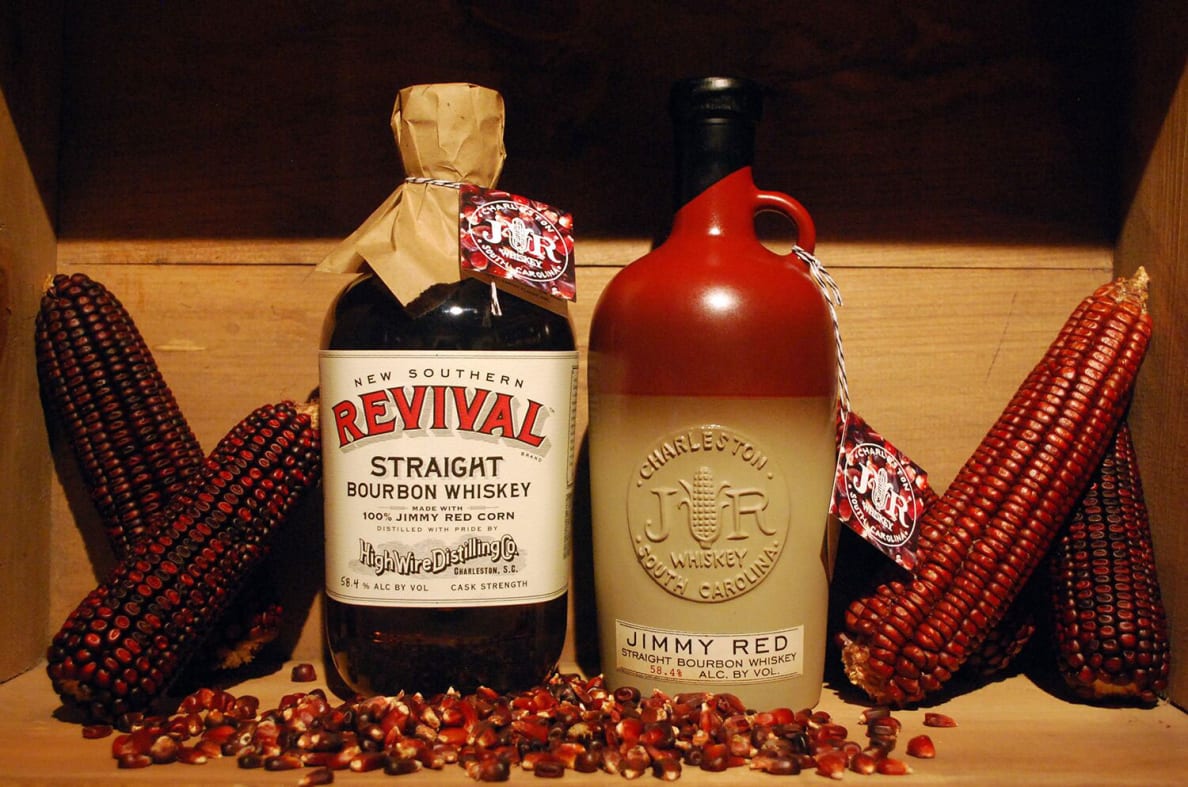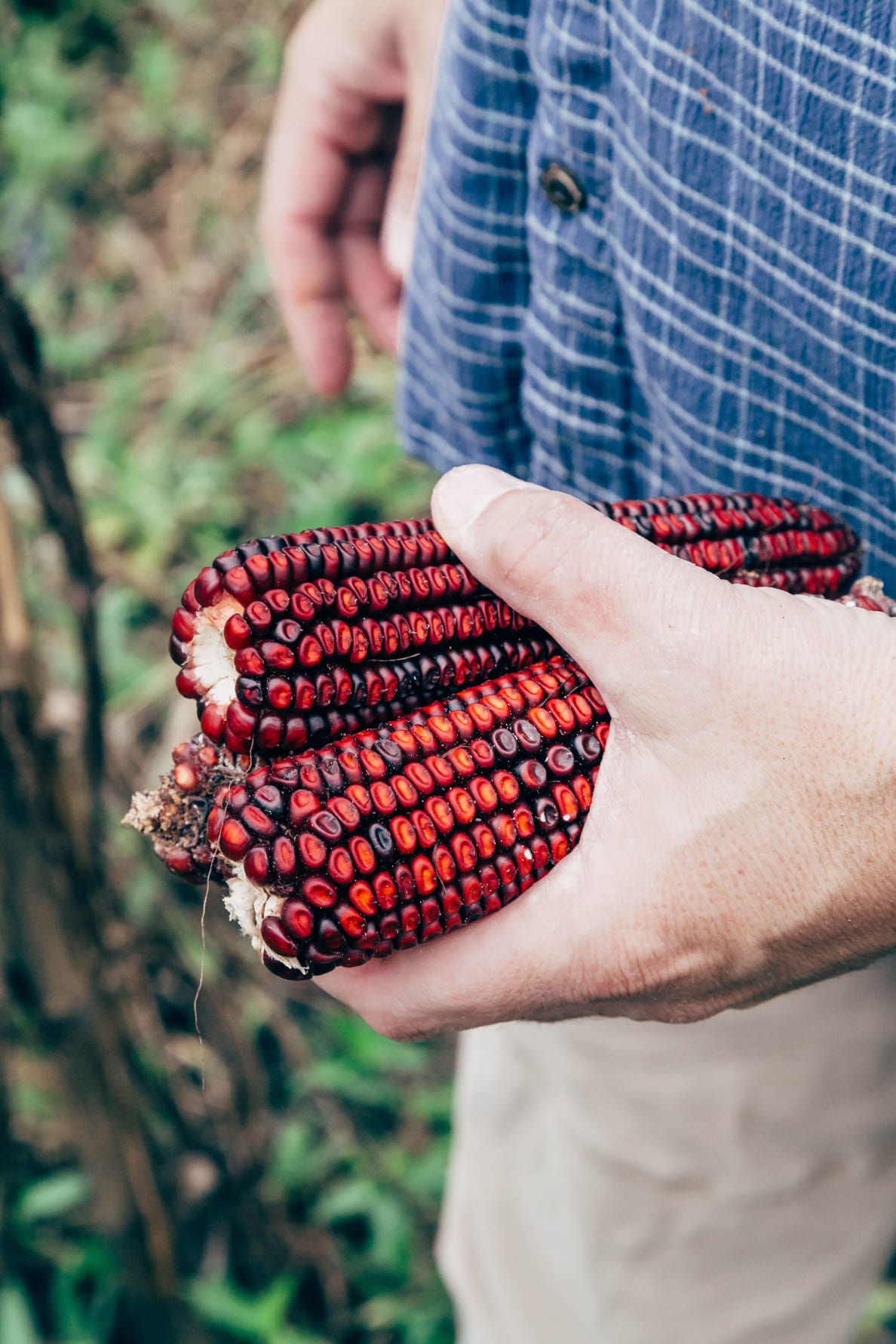High Wire Jimmy Red Straight Bourbon Whiskey Review
Northew Southern Revival Straight Bourbon from High Wire Distillery in Charleston, S Carolina, is fabricated from a mash consisting merely of Jimmy Red Corn. It's an one-time hooch corn, with beautiful, ragged runs of kernels that vary from fire orange to a deep, purplish cherry. It's named subsequently James Island, South Carolina, where information technology was grown for decades and near drifted off into extinction.
"Cool name, absurd story, simply information technology tastes different, and that'southward what's important," says Scott Blackwell, who started High Wire distilling with his wife Ann Marshall in 2013. Their work was recognized this year with a nomination for the James Beard Award for outstanding wine, spirits or beer producer.
Blackwell came from a baking background—"nutrient and season" he says. He paid his way through college blistering pies. He then started the Immaculate Baking Company in his garage in 1995, and in 2012 sold information technology to Full general Mills. "I've been in the food business my whole life, all the way back to 15, washing dishes, working at fish camps."
He didn't come to distilling with a degree in chemic engineering or a family tradition to uphold. "Our grandpappy doesn't have some recipe," he's quick to point out and he didn't have all that much feel in liquor, either. He was thinking maybe a brewery. Ann seems to have seen the future first. When he was growing up, after all, the booze you could make it South Carolina came in mini-bottles stacked on the back bar. For almost of his life, he didn't even think of spirits as something that might be good to drinkable.

High Wire Distillery
I suspect he was well-served by this lack of inherited wisdom.
For it is a long-held industry belief that the type of corn one uses to make bourbon doesn't contribute much to the season.
"They believe that afterwards 4 years the corn lays down and the butt becomes the season, considering of the sugar and how it reacts," he says. "Well, with yellow or white corn, information technology does simply go away, and you're playing off that sugar."
Any grain flavor from the corn has been supplanted past the big flavors of new American oak.
Blackwell was puzzled, also, by the language of distillers who typically refer to the smaller percentages of rye or wheat in the mash bill as "season grains." Why, he wondered, would you ignore the season profile of your corn in a production that is generally corn?
"Information technology's like tomatoes or mushrooms, a white mushroom, versus a shitake, versus a morel—information technology'due south all going to have different flavors," he says.
So Blackwell needed to observe a person who knew a lot well-nigh the history of corn and heirloom grains. That pilgrimage led him to Glenn Roberts who is the founder of Anson Mills and a local Charleston fable who brought back Carolina aureate rice. Roberts showed him a table total of corn. "He'due south very manic," says Blackwell. In that location were all sorts of varieties, all sorts of characteristics, and Roberts kept skipping around, showing Blackwell and his wife everything before he finally unveiled the Jimmy Ruby. "Finally he says 'that's an old hooch corn, that's the one you want.'"
They started tiresome—forty pounds of Jimmy Red seed grown on nearly 2 acres. The yield of heritage grains such as Jimmy Cherry isn't what it would be if you were growing newer, optimized grains, but the crop came in, fifty-fifty though they ended up having to harvest information technology by hand.
Once they ground the kernels and got the cornmeal into the fermenter, Blackwell could tell it was something different. "Information technology doesn't smell corny at all," he says. "It's got this three-inch oil cap on it, it's got this purplish blood-red color to it."
He'd never seen that in test runs of other types of corn and when the white dog started flowing off the notwithstanding, information technology was apparent that they were on to something different, and something good. The alcohol was circuitous, Blackwell says, with a pleasant viscosity. He tasted light spice, bawdy undertones, and marzipan.
From that moment, he was a man obsessed with Jimmy Red.
He read Anthony Boutard's book, Cute Corn , and learned about the 59 unique types of corn available. Blackwell found himself cupping corn porridges and tasting varieties. But he still didn't empathise exactly what he was tasting or how these flavors developed.
"What are the genetics on that?" he asked "Where are these flavors coming from? What else is out in that location?"
Blackwell made a giant step in his agreement when he began to learn nearly the correlations between color and season. "Jimmy Red has a high level of beta carotene, it too has a high level of anthocyanin." In addition, it's full of a flavonoid, which makes things taste like cinnamon.
He talked about it, he says, for a yr, until Roberts came to him and asked him if he wanted to go to Oaxaca and practice a deep dive on the origins of the corn variety.
He began packing immediately.
They went to kitchens, to markets, to a country-run center for agronomical enquiry, looking for the ancestors of the southeastern dent corns, which came n two chiliad years ago, and were traded by Native Americans. But tracing the corns tin can be difficult. There are no records, no 1 wrote the information down, and many traditions were lost.
He'south only half kidding when he says that he has come up to think of himself as a maize archaeologist.
Knowingly echoing famed southern writer Wendell Drupe's maxim that eating is an agricultural act, Blackwell says, "I don't really see information technology as booze anymore. It's agriculture."
In the glass, his Jimmy Scarlet bourbon is more than mature than it should exist. It's got a nectar soft sweetness, and finishes with a mineral earthiness reminiscent of Muscadet. It'south nonetheless got corn flavour, merely not much of that polenta and corn flake flavour that clings to immature whiskies.
High Wire harvested near 250,000 pounds of the special corn final year and is expecting to double that this year. The stance of using heritage grains to brand whiskey has also started to fortunately change. Westland in Seattle and Leopold Brothers in Denver, are making acclaimed whiskey with heritage strains of barley and rye, and Woodford Reserve chief distiller Chris Morris has tried a number of obscure corn varieties as has Buffalo Trace.

Peter Frank Edwards
Blackwell's side by side project is constructing a genetic fingerprint of Jimmy Red Corn, so he tin build a hypothesis of its origins. Maybe he'll make an ancestral series of whiskies that would highlight the diaspora.
"That would be interesting for us," he says. Every bit I swirled the terminal scrap of his whiskey in my glass, I couldn't agree more.
Source: https://www.thedailybeast.com/high-wire-distillery-in-charleston-south-carolina-thinks-the-future-of-bourbon-is-heritage-grains
0 Response to "High Wire Jimmy Red Straight Bourbon Whiskey Review"
Post a Comment